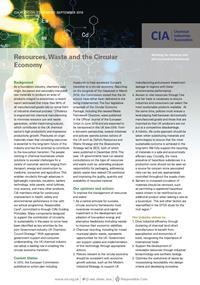Efficiency is engrained into chemical manufacturing to minimise resource use and waste generation, whilst maximising outputs, which contributes to the UK chemical sector’s high productivity and impressive productivity growth. Pressures on virgin materials mean that circulating resources is essential to the long-term future of the industry and has the potential to contribute to the low-carbon transition. The people working in chemical businesses unlock solutions to societal challenges for a variety of customer sectors ranging from transport, energy and construction to medicine, consumer and agriculture. This enables circularity through advances in lightweight materials, insulation, battery technology, solar panels, wind turbines, crop science, and many other products.
CIA members strive for continuous improvement in health, safety and environmental performance in line with our ethical programme, Responsible Care®, committed to through CIA’s Guiding Principles. Many components designed to support the contribution of circularity to sustainability in the years to come have been identified as key priorities by the joint Government-industry UK Chemistry Council Strategy.2 With appropriate government support and consumer understanding, the UK chemical industry can adopt a leading role in enabling the circular economy transition.
Current Status
In 2015, the European Commission published an action plan including measures to help accelerate Europe’s transition to a circular economy. Reporting on the progress of the measures in March 2019, the Commission stated that the 54 actions have either been delivered or are being implemented. The four legislative proposals of the Circular Economy Package, including the revised Waste Framework Directive, were published in the Official Journal of the European Union in June 2018 and are expected to be transposed in the UK late-2019.
From a domestic perspective, several initiatives and policies operate across nations of the UK such as Defra’s Resources and Waste Strategy and the Bioeconomy Strategy led by BEIS, both of which were published in December 2018. This year, UK governments have run several consultations on the topic of resources and waste such as: extending producer responsibility for packaging, addressing plastic waste (see related CIA positions) and improving the quality, quantity and availability of recycled material.
Our opinion and actions
To improve the management of resources and waste:
- As a central principle for success, circular economy frameworks must incentivise innovation and capital investment in the development and adoption of low-carbon energy and alternative feedstocks (including waste) to improve their economic viabilities.
- Chemical recycling, including for mixed municipal plastic waste, represents opportunities for the UK. Government can support uptake and implementation of this technology through appropriate actions.
- Policies relevant to the circular economy should be consistent with economic growth policies, such as the Modern Industrial Strategy, to support UK manufacturing and prevent investment leakage to regions with lower environmental performance.
- Access to vital resources through free and fair trade is necessary to ensure industries and consumers can select the most sustainable products available. At the same time, policies must ensure a level playing field between domestically manufactured goods and those that are imported so that UK producers are not put at a competitive disadvantage.
- A holistic, life cycle approach should be taken when substituting materials and technologies to ensure that the most sustainable outcome is achieved in the long term. We fully support the recycling of materials in a safe and economically efficient way. Crucially, the mere presence of hazardous substances in a production cycle should not be seen as a source for concern since associated risks can be, and are, appropriately controlled throughout the supply chain.
- Barriers to increased circulation of materials should be removed, such as permitting a registered hazardous waste stream to be redefined as an additional product when leaving a site as a by-product. This and other factors are exemplified in the EPOS study for the Hull region.

Resources, waste and the circular economy
CIA members strive for continuous improvement in health, safety and environmental performance in line withour ethical programme, Responsible Care®, committed to through CIA’s Guiding Principles. Many components designed to support the contribution of circularity to sustainability in the years to come have been identified as key priorities by the joint Government-industry UK Chemistry Council Strategy.
DOWNLOADPDF | 2.76 Mb























